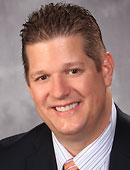

Alarms Coalition Kicks Off with Plenty of RT Involvement
April 30, 2014

Doug Laher

Matthew Trojanowski
AARC Associate Executive Director Doug Laher, MBA, RRT, FAARC, and member Matthew Trojanowski, MS, RRT, represented the Association at the inaugural meeting of the National Coalition for Alarm Management held in Washington, DC., on April 24-25, bringing the RT’s voice to bear on efforts to streamline the use of clinical alarms in the hospital setting.
Driven by the Association for the Advancement of Medical Instrumentation, the meeting was attended by representatives from The Joint Commission, FDA, National Patient Safety Foundation, other health care organizations, industry, and 20 hospitals on the cutting edge of alarm safety.
Joining Laher and Trojanowski at the table were three other respiratory therapists: Greg Spratt, BS, RRT, CPFT, who was there to represent Covidien, Russelle Cazares, MS, RRT, who came on behalf of Los Angeles Children’s Hospital, and Sarah Williams, MBA, RRT, who represented Extension Healthcare.
Key goals
Laher says the key goals of the initiative are to develop a white paper, best practice document, and/or compendium of literature highlighting opportunities for caregivers to better manage alarm safety in their hospitals. Noting that alarm fatigue is a Joint Commission National Patient Safety Goal (NPSG), he says hospitals across the country will welcome the guidance.
“Targeting opportunities is required over the next two years; however institutions must have fully integrated processes implemented in their facilities to address this issue by 2017,” says Laher. “It is the goal of the coalition to provide support and direction to caregivers regarding the NPSG and directions to manufacturers so that the alarm packages in their equipment are synonymous with the NPSG.
Trojanowski believes the coalition’s efforts to involve all the key players in alarm management will ensure a cohesive approach to the problem.
“This is a global issue that cannot be solved by one group, entity, or organization,” emphasizes manager of adult respiratory care services at Johns Hopkins. “The coalition brings regulatory agencies, professional organizations, and caregivers together to identify problems and gaps in technology, understanding, and comprehension.”
These stakeholders will collaboratively develop solutions that focus not only on alarms and the noise and volume they produce, but on establishing guidelines for the parameters that should be set for selected patients, agreed upon delays before an alarm goes off, and perhaps most importantly, strict response times for alarms and physiologic parameters that affect patient outcomes.
RTs front and center
The fact that five RTs were in attendance at the meeting speaks volumes about the importance of the RT to this process.
“We play an active role in addressing this issue because of our intimate involvement and knowledge of mechanical ventilators and the care of the mechanically ventilated patient,” emphasizes Laher. “In addition, we often are called on to respond to other physiologic alarms such as pulse oximetry.”
Trojanoswki and Cazares both presented an overview of alarm management at their hospitals to the group, and Trojanoswki also shared data on alarms being collected at Johns Hopkins. Laher offered consultation regarding issues, talking points, and suggested opportunities for the future.
The next steps for the coalition will be to share a transcript of the meeting with stakeholders and develop common themes, challenges, and concerns. From there, subcommittees will be established to develop recommendations for respective categories.